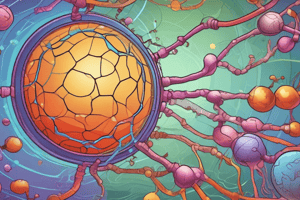Podcast
Questions and Answers
What percentage of the total energy of glucose is released as heat during aerobic respiration?
What percentage of the total energy of glucose is released as heat during aerobic respiration?
- 38%
- 25%
- 62% (correct)
- 90%
In the absence of oxygen, how many ATP molecules are produced from one molecule of glucose?
In the absence of oxygen, how many ATP molecules are produced from one molecule of glucose?
- 0
- 4
- 38
- 2 (correct)
What is the purpose of fermentation in anaerobic respiration?
What is the purpose of fermentation in anaerobic respiration?
- To regulate body temperature
- To generate more ATP
- To release energy as heat
- To convert NADH to NAD+ (correct)
Which type of fermentation is used by yeast and some microorganisms?
Which type of fermentation is used by yeast and some microorganisms?
What is the byproduct of ATP synthase?
What is the byproduct of ATP synthase?
Which process occurs in the presence of oxygen?
Which process occurs in the presence of oxygen?
What is the net ATP production from glycolysis in the presence of oxygen?
What is the net ATP production from glycolysis in the presence of oxygen?
What is the purpose of the electrochemical gradient in cellular respiration?
What is the purpose of the electrochemical gradient in cellular respiration?
What is the byproduct of lactic acid fermentation that causes a painful burning sensation in muscles?
What is the byproduct of lactic acid fermentation that causes a painful burning sensation in muscles?
Which stage of cellular respiration produces the most ATP?
Which stage of cellular respiration produces the most ATP?
What is the advantage of anaerobic respiration over aerobic respiration?
What is the advantage of anaerobic respiration over aerobic respiration?
Where does the Krebs cycle take place in the cell?
Where does the Krebs cycle take place in the cell?
What is the purpose of high-energy electrons in the Electron Transport Chain?
What is the purpose of high-energy electrons in the Electron Transport Chain?
What is the equation for lactic acid fermentation?
What is the equation for lactic acid fermentation?
What is the location of glycolysis in the cell?
What is the location of glycolysis in the cell?
What is the relationship between cellular respiration and photosynthesis?
What is the relationship between cellular respiration and photosynthesis?
What is the net ATP yield of anaerobic respiration per glucose molecule?
What is the net ATP yield of anaerobic respiration per glucose molecule?
Which stage of aerobic respiration produces the most ATP?
Which stage of aerobic respiration produces the most ATP?
What is the purpose of fermentation in anaerobic respiration?
What is the purpose of fermentation in anaerobic respiration?
Which type of fermentation is used by humans?
Which type of fermentation is used by humans?
What is the difference between aerobic and anaerobic respiration in terms of ATP yield?
What is the difference between aerobic and anaerobic respiration in terms of ATP yield?
What is the stage of aerobic respiration that occurs before the Electron Transport Chain?
What is the stage of aerobic respiration that occurs before the Electron Transport Chain?
Study Notes
Cellular Respiration
- The electrochemical gradient is created for ATP synthase to work.
- ATP synthase converts ADP into ATP.
Total ATP Production of Aerobic Cellular Respiration
- 2 ATP molecules are produced from glycolysis in the absence of oxygen.
- 2 net ATP molecules are produced from glycolysis in the presence of oxygen.
- 36 more ATP molecules are produced from the Krebs Cycle and electron transport.
- A total of 38 ATP molecules are produced, which represents 38% of the total energy from glucose.
Anaerobic Respiration
- Anaerobic respiration occurs in the absence of oxygen and involves fermentation.
- Fermentation releases energy from food molecules in the absence of oxygen.
- There are two types of fermentation: alcoholic fermentation and lactic acid fermentation.
Alcoholic Fermentation
- Yeast and some microorganisms use alcoholic fermentation to produce ethyl alcohol and carbon dioxide.
- Equation for alcoholic fermentation: pyruvic acid + NADH → ethyl alcohol + CO2 + NAD+
Lactic Acid Fermentation
- Many cells convert pyruvic acid to lactic acid, regenerating NAD+ to continue glycolysis.
- Equation for lactic acid fermentation: pyruvic acid + NADH → lactic acid + NAD+
Stages of Respiration
- Aerobic respiration: glycolysis, Krebs Cycle, and electron transport chain.
- Anaerobic respiration: glycolysis followed by fermentation.
Comparison of Aerobic and Anaerobic Respiration
- Aerobic respiration is more energy-efficient, producing up to 38 ATP per glucose.
- Anaerobic respiration yields only 2 ATP per glucose.
- Aerobic respiration requires oxygen, while anaerobic respiration occurs in the absence of oxygen.
Relationship between Cellular Respiration and Photosynthesis
- Equation for cellular respiration: 6O2 + C6H12O6 → 6CO2 + 6H2O + energy (ATP).
- Equation for photosynthesis: 6CO2 + 6H2O + energy (sunlight) → 6O2 + C6H12O6.
Studying That Suits You
Use AI to generate personalized quizzes and flashcards to suit your learning preferences.
Description
This quiz covers the process of ATP synthesis, including the electrochemical gradient, ATP synthase, and the total ATP production in aerobic cellular respiration.





